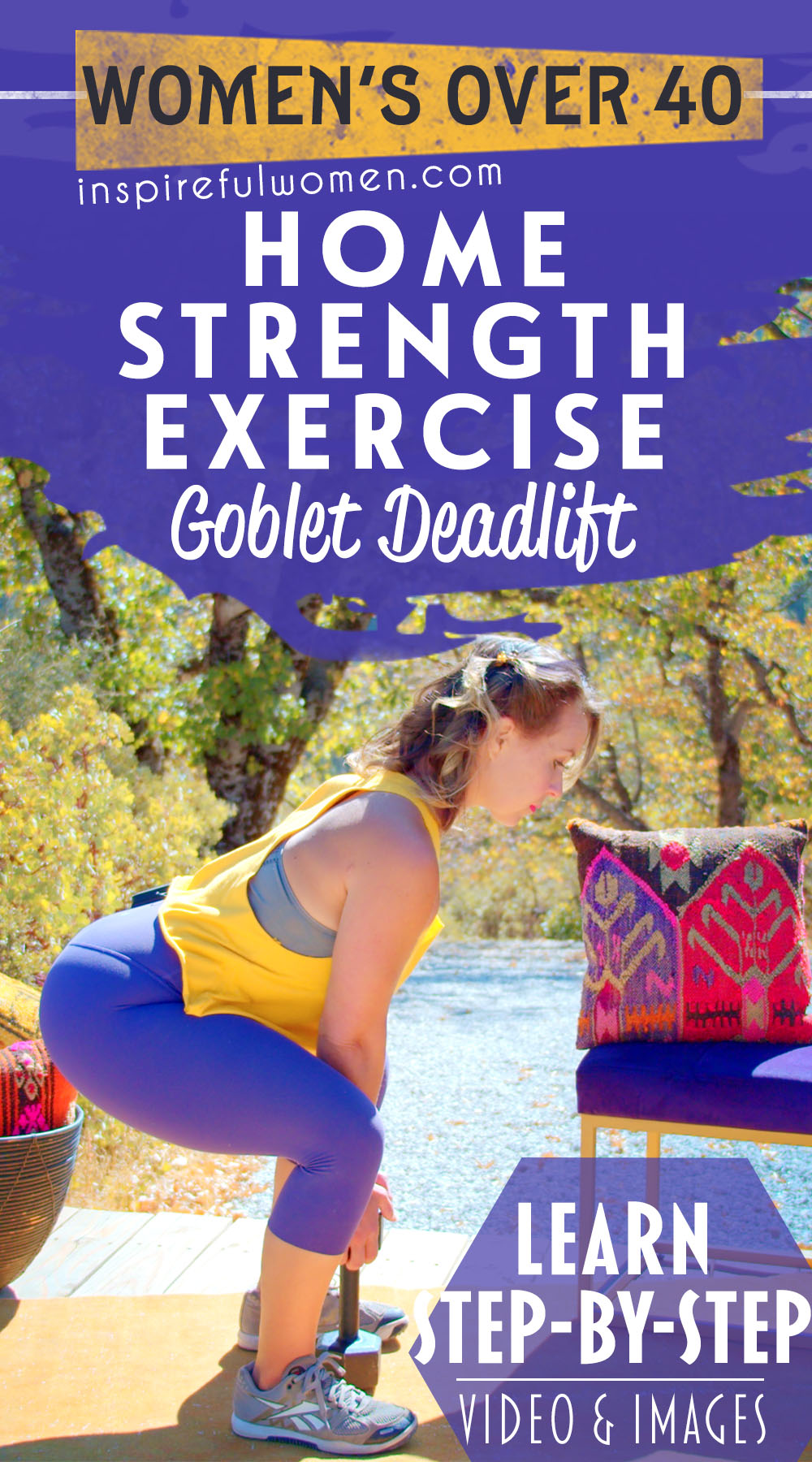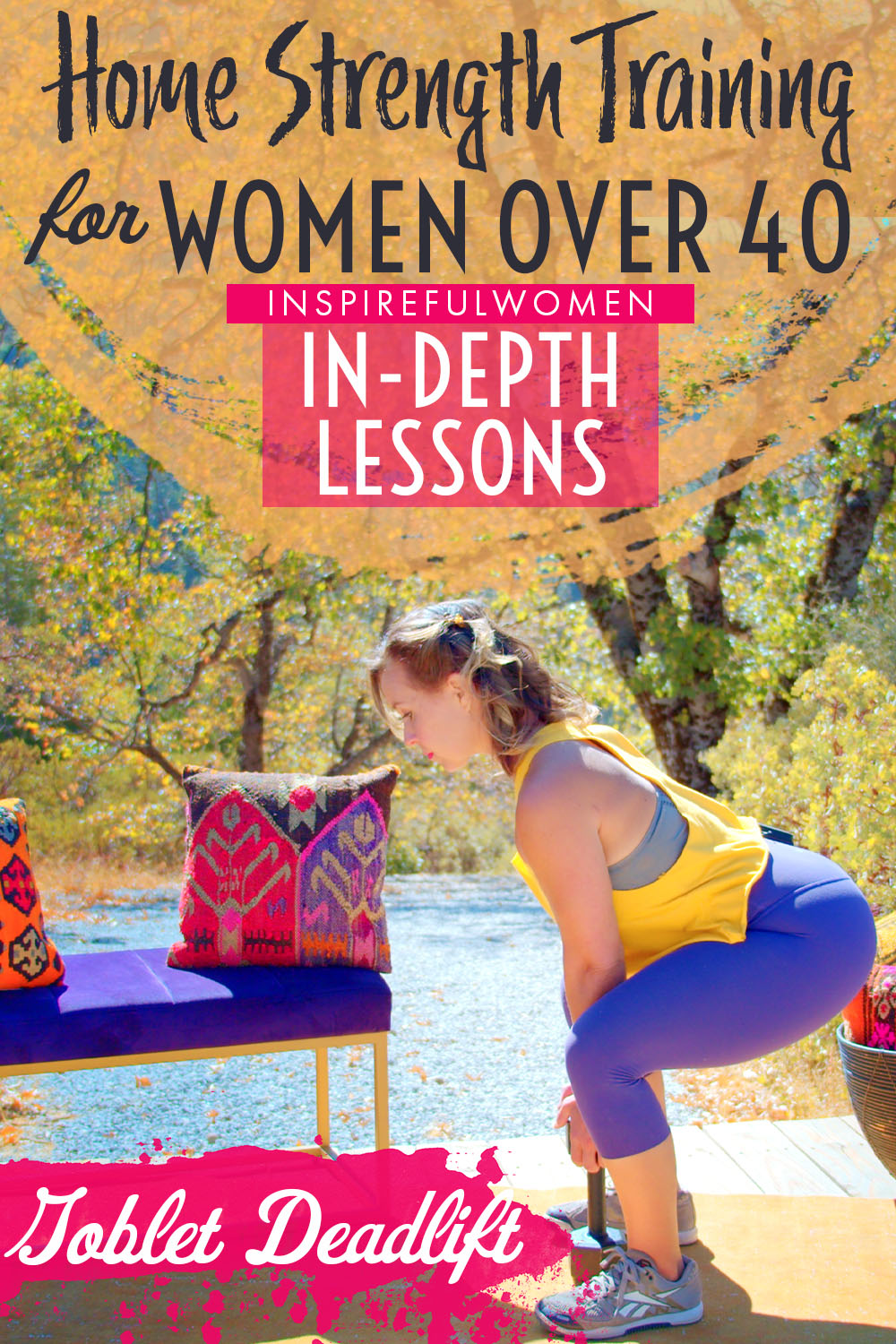Goblet Dumbbell Deadlift
How to Do Standing Goblet Dumbbell Deadlifts | In-Depth Guide [VISUAL LEARNERS] Beginner
Proper Form, Common Mistakes, & Easier Variations | Home Resistance Training
WHAT DO YOU WANT TO SEE?
QUICK DEMO
QUICK DEMO
MUSCLES THIS WORKS
MUSCLES
MAIN MUSCLES WORKED IN the Goblet Deadlift
GLUTEUS MAXIMUS, QUADRICEPS, AND HAMSTRINGS
OTHER MUSCLES WORKED:
- Adductor magnus
- Gastrocnemius
- Soleus
- Erector spinae
- Lats
- Quadratus lumborum
- Transverse abdominis
STARTING POINTERS
Starting Pointers
WHAT WE'RE DOING TODAY
ALL WE'RE DOING:
A simple bending over at the hips and then standing up again.
This lower body compound movement is not only effective but also convenient, as it can be performed right in the comfort of your own home. This is a deadlift variation using one dumbbell held longways instead of a weight bar with plates.
This lower body strength exercise is a multi-joint exercise, there is movement at the hips and the knees. The exercise has two steps, hinging at the hips and then bending the knees to reach the weights, and reversed to lift the weights - straightening the knees and then the hips. The hamstrings and gluteus maximus will work together when you hinge at the hips. The muscles will be lengthening (eccentric contraction) as you hinge forward and shortening as you straighten back up. The quadriceps will be working the same way, lengthening as the knees bend, and shortening as the knees are straightened. Make sure that you have mastered a hip hinge with a neutral spine before adding the weights.
HOW TO DO THE EXERCISE
LOOKS
HOW Goblet Dumbbell Deadlifts SHAPE OUR BODY
Tones and shapes buttocks, front and back of thigh.
PROPER FORM
PROPER FORM: Goblet Dumbbell Deadlift
EQUIPMENT, SETS & REPS
EQUIPMENT
SUGGESTED STARTING WEIGHT FOR WOMEN:
10-20 pounds.
SETS & REPS:
2 sets of 8 reps.
PACE:
Slow and controlled. Can lift up quicker and lower more slowly.
BODY POSITION
BODY POSITION FOR THE Goblet Deadlift
Place the dumbbell vertically, resting on one of the ends, between your feet in line with your toes.
FEET: Stand with feet hip-width apart. Toes forward.
BODY STANCE: Spine in neutral. Sternum lifted shoulder blades in and down your back. Legs straight, knees soft (not hyperextended or locked). Hinge forward at your hips. The proper depth of your hip hinge is when your hands are in line with your knee joints, and your hips are lower than your shoulders and higher than your knees. Bend your knees and ankles to lower yourself down to reach the dumbbell.
NECK: In order to keep your neck in neutral during the entire movement, I find that having my eyes slightly downcast during the entire range of motion is best for me. This allows your neck to stay the same as you go up and down. If you gaze straight ahead at the top of the movement, I find that then as I lower into the movement, my neck will end up extending back in order to keep my eyes where they were, which is what you want to avoid.
Your neck should not move - this becomes more important with heavier weights. This exercise actually strengthens the muscles of the back of your neck, you want to make sure that they are strengthened in the healthiest position.
ARMS: In front of your thighs, hanging straight down. Your hands should be in line with your shoulders throughout the exercise.
GRIP: When you reach the dumbbell, pick up the dumbbell with both hands. Securely cup the upper head of the dumbbell with both of your hands.
HOW TO DO
HOW TO DO Goblet Dumbbell Deadlifts
CUE: Pulling your shoulder blades down your back will help to activate your lats which work with your gluteus maximus to stabilize your low back during the hip hinge. When you push down through your feet it should feel like you are trying to push the floor away from you.
Grasping the weight, press down through your feet to straighten your knees and ankles.
The weight will be close to your shins and your weight should be over the arches and heels of your feet. Once your hands are in front of your knees, pull your hips forward to bring them in line with your spine and legs. Straighten your legs and squeeze your glutes at the top. Keep your spine in neutral, shoulder blades down and in, and sternum lifted. Stack your shoulders over your hips and over your feet.
Hinge forward at the hips, bend at the knees to set the weight on the floor. The next rep begins when you straighten your leg to lift the weight back up.
HOW TO SAFELY GET OUT OF THE EXERCISE
Hip hinge until hands are at knee joint line, bend your knees to squat down to set the weight on the floor. Push up to standing.
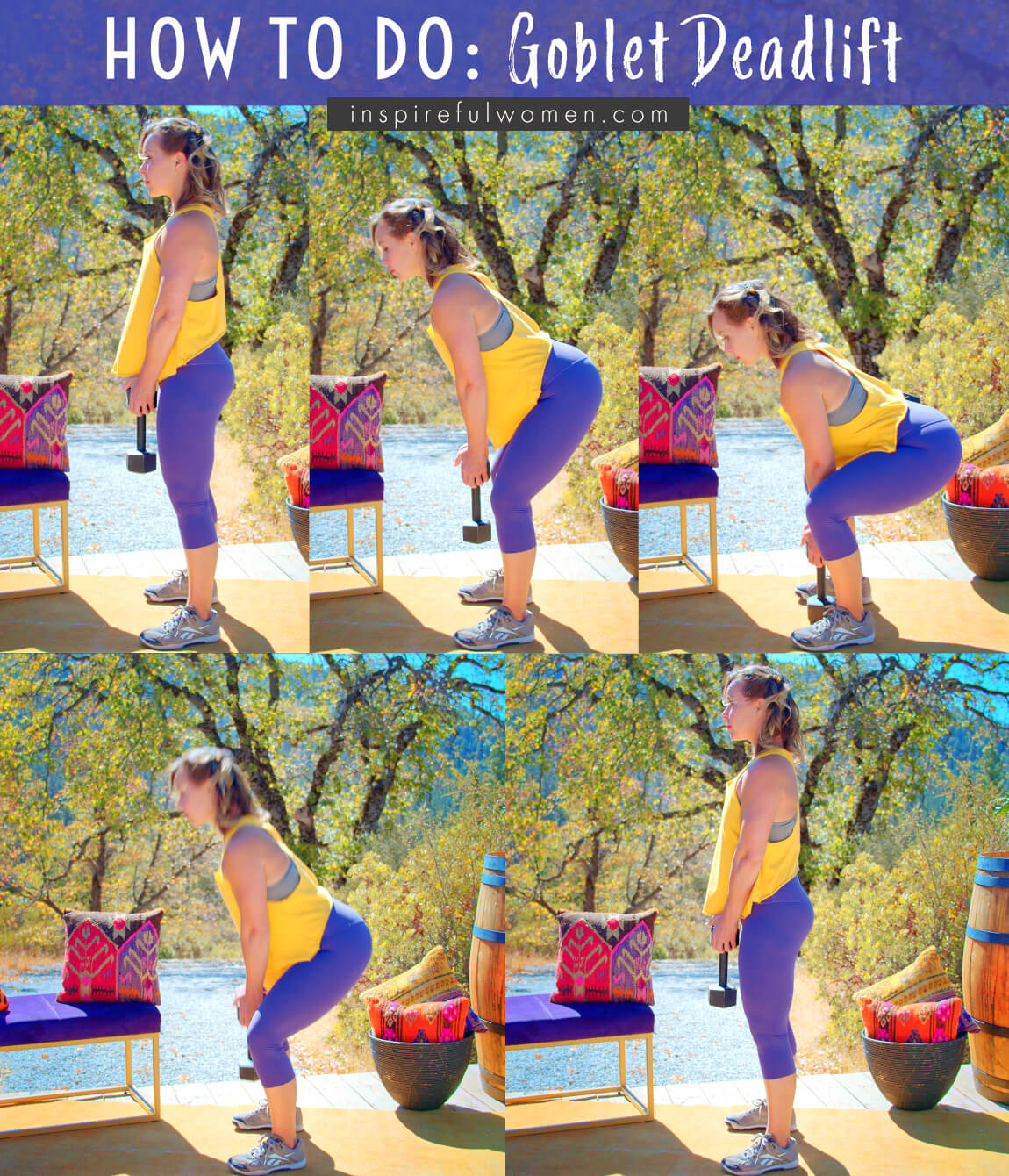
COMMON MISTAKES
COMMON MISTAKES
WHAT TO AVOID WITH THE Goblet Deadlift
KEY TIP:
Guess what? Good news! Many avoids are the same for most movements. Once you learn the basics, there's really only a few extra avoids for each individual movement.
1. Avoid Rounding Spine
AVOID: Avoid rounding the back.
WHY NOT?
- This is mostly just a habit developed from years of using your back to lift.
- This can also happen when you use too much weight. (This would be the crowbar example - or the fishing pole. You only can lift the weight without injury if the back muscles are strong enough to hold the back in a safe position.)
WHAT TO DO:
- Begin with no weight or lighter weight and just practice your form, add weight slowly.
- Keep your sternum lifted and your abdominals engaged to help keep your spine neutral.
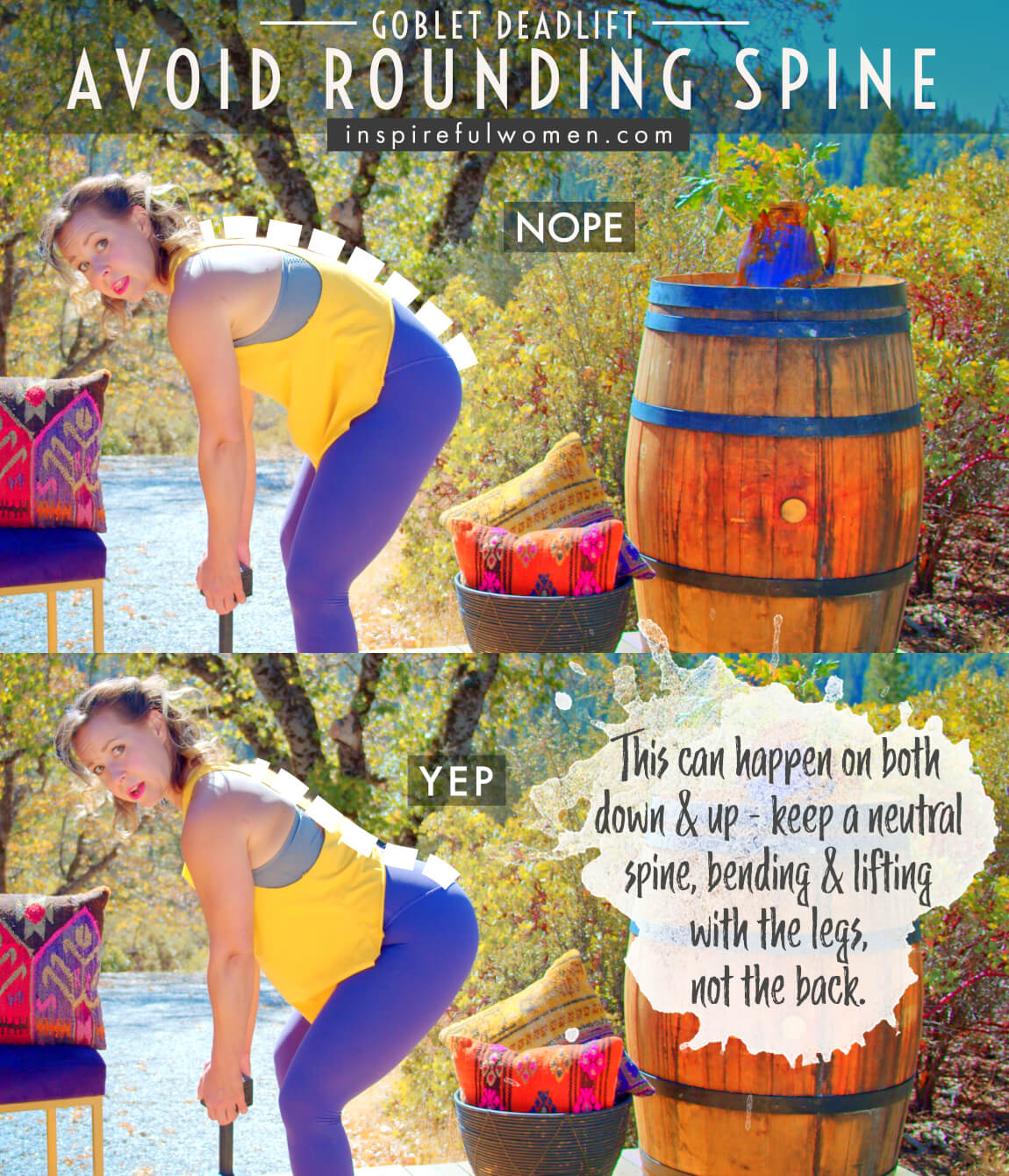
2. Avoid Shallow Hip Hinge
AVOID: Avoid not hinging with hips far enough.
WHY NOT?
- Not hinging far enough could increase the strain on the shoulders and low back.
- May cause you to have to squat too far, using more quadriceps and less hip extensors.
WHAT TO DO:
- The hips should be between the height of the shoulders and the knees.
- The hands should be directly under the shoulders throughout the exercise.
- If you cannot hinge far enough forward because your hamstrings are tight - try stretching them before the exercise.
- If you still cannot hinge far enough forward - work on hip hinging before doing the deadlift.
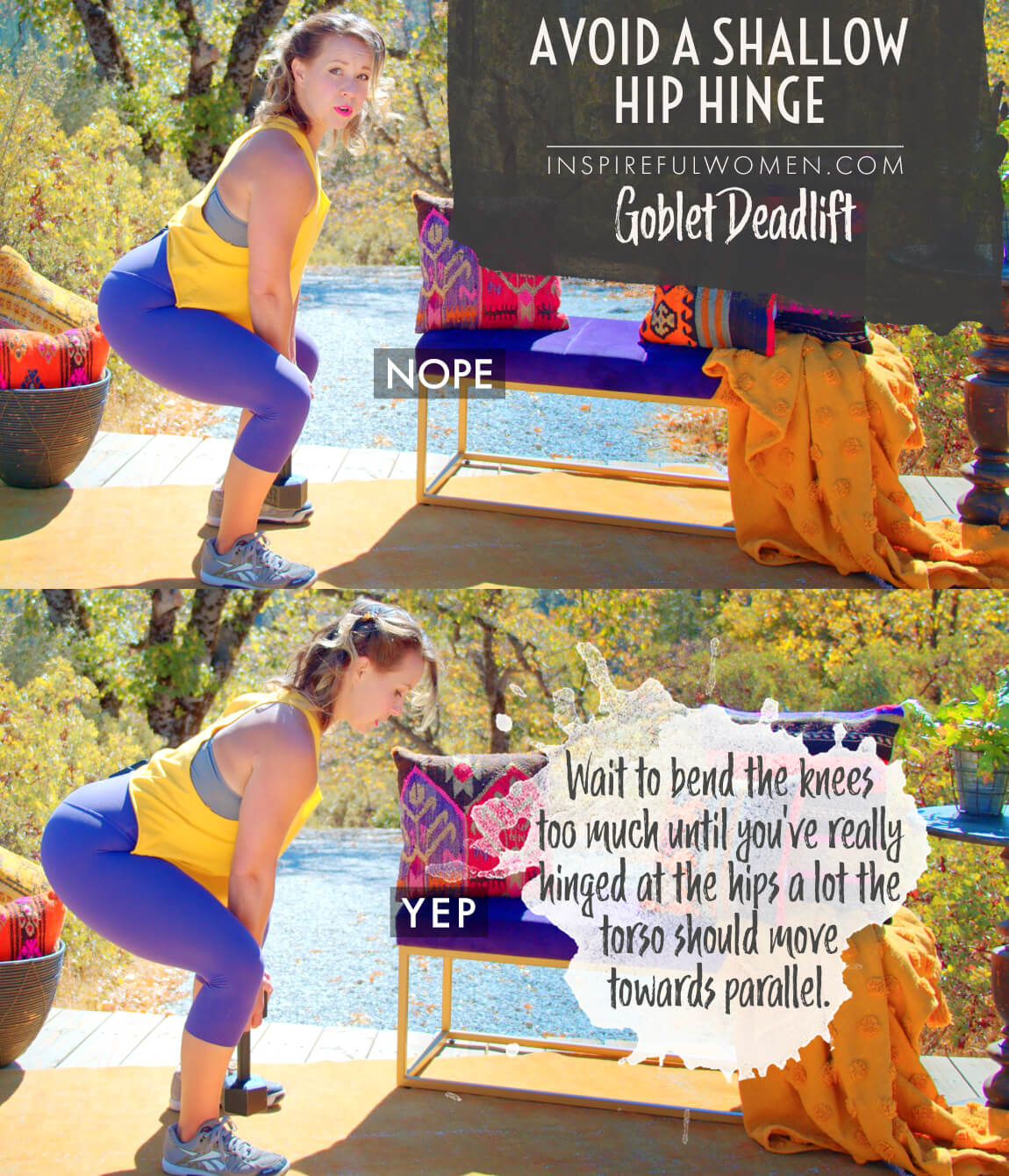
3. Avoid Pelvic Tilt
AVOID: Avoid doing a pelvic tilt at the top of the movement when extending your hips.
WHY NOT?
- The goal of this exercise is to train the gluteus maximus and hamstring to pull the leg backward relative to the pelvis.
- Moving the pelvis is movement of the spine - this can irritate the joints and muscles over time.
WHAT TO DO:
- Do not make the mistake of substituting this movement of the pelvis for movement of the hip - the thigh bone in the socket of the pelvis.
- At the end of the hip extension, use the gluteus maximus to extend the leg in the socket of the pelvis but do not tilt your pelvis.
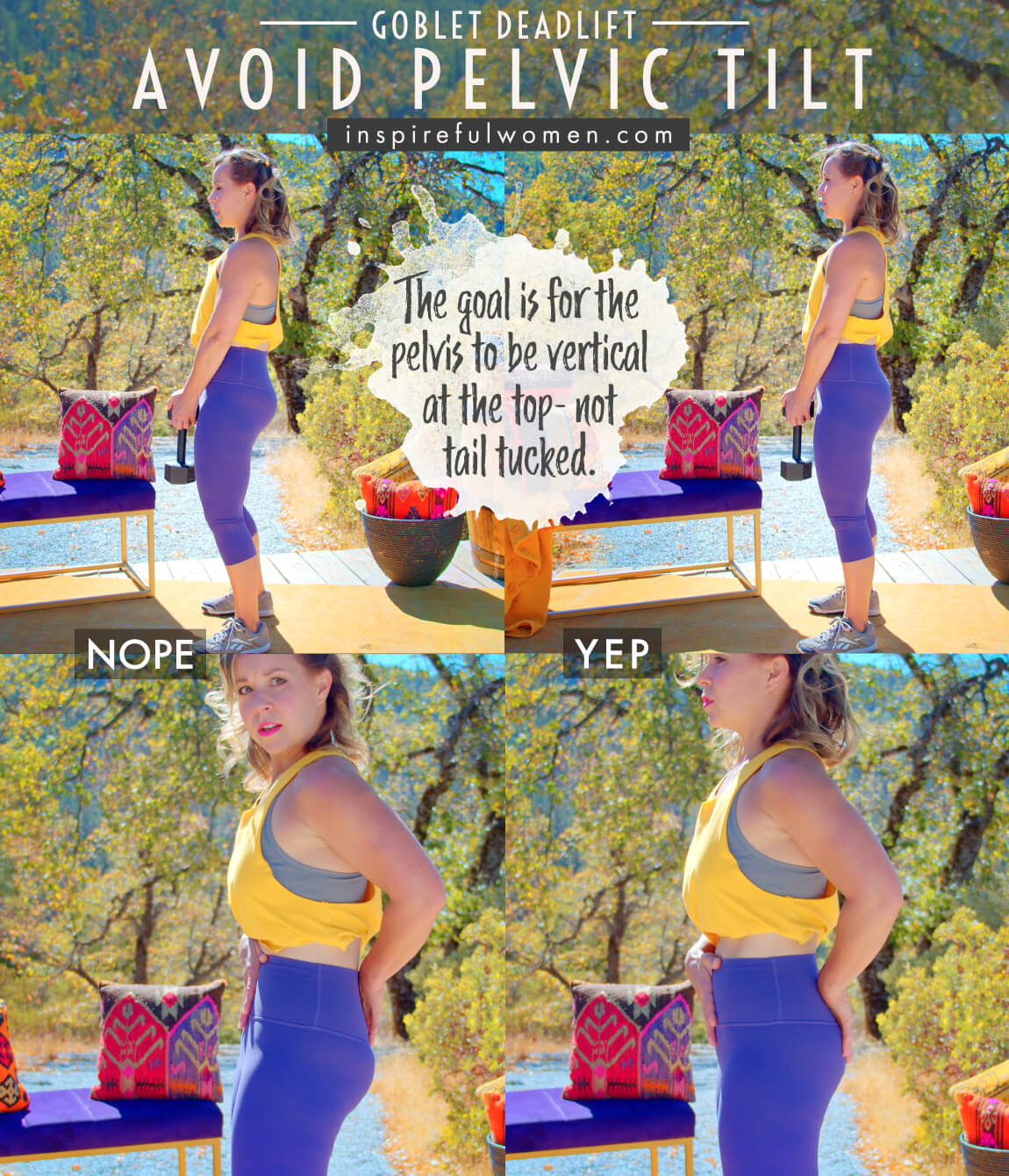
4. Avoid Pushing Hips Forward
AVOID: Avoid pushing your hips too far forward at the top of the movement.
WHAT TO DO:
- At the top of the movement, your back should be neutral, not arching.
- Sometimes people will push the hips too far forward so that the shoulders are behind the hips.
- Push the hips forward only until the shoulders are stacked over the hips.
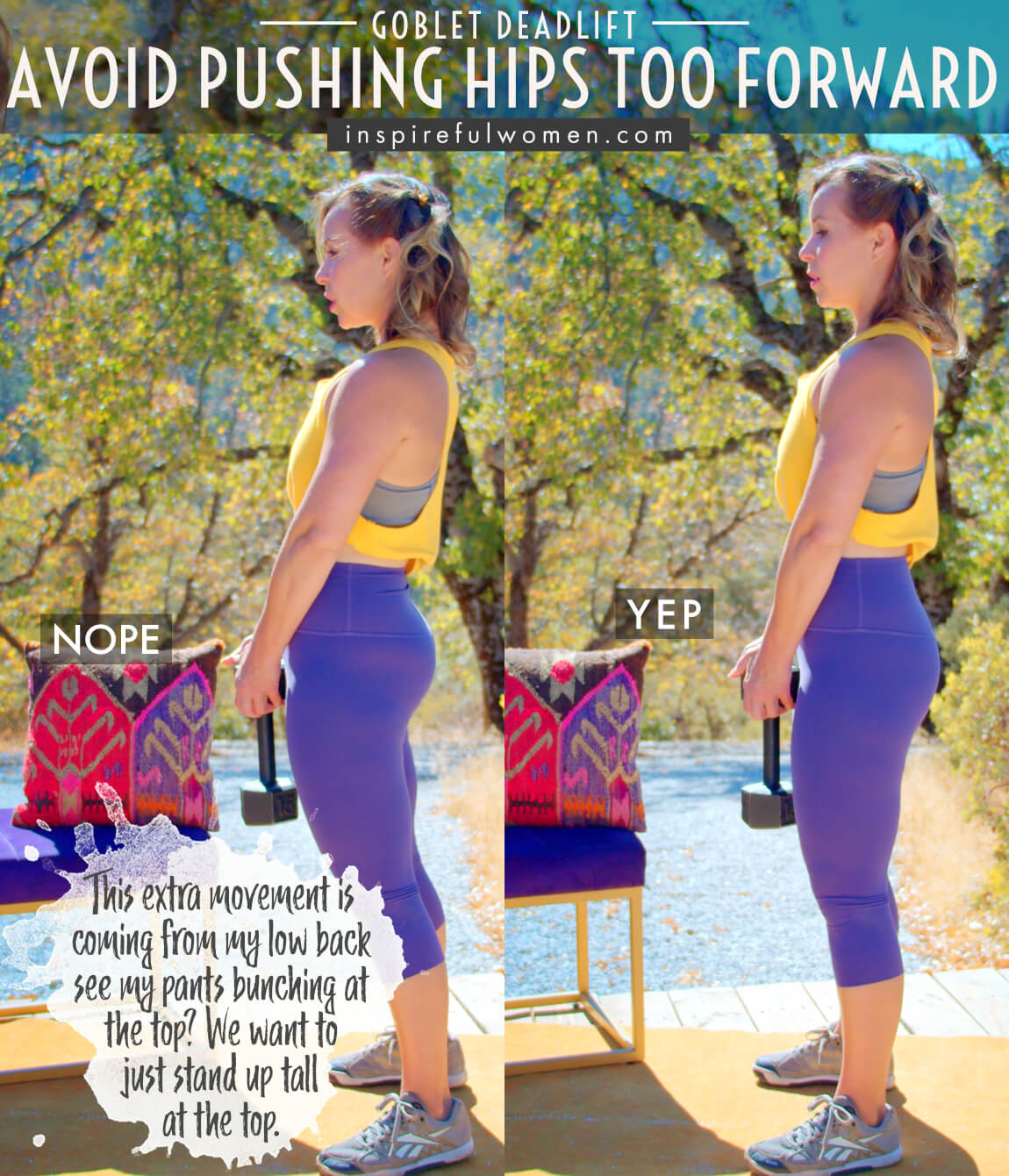
5. Avoid Lifting Chin
AVOID: Avoid lifting your chin as you hinge.
WHY NOT?
- This can cause a neck strain.
WHAT TO DO:
- Remember that your neck is part of your spine.
- Deadlifts do strengthen the neck muscles when you lean over.
- Keep the entire spine in neutral to strengthen the muscles in the healthiest position.
- Looking slightly down during the entire range of motion may help to keep the neck in neutral.
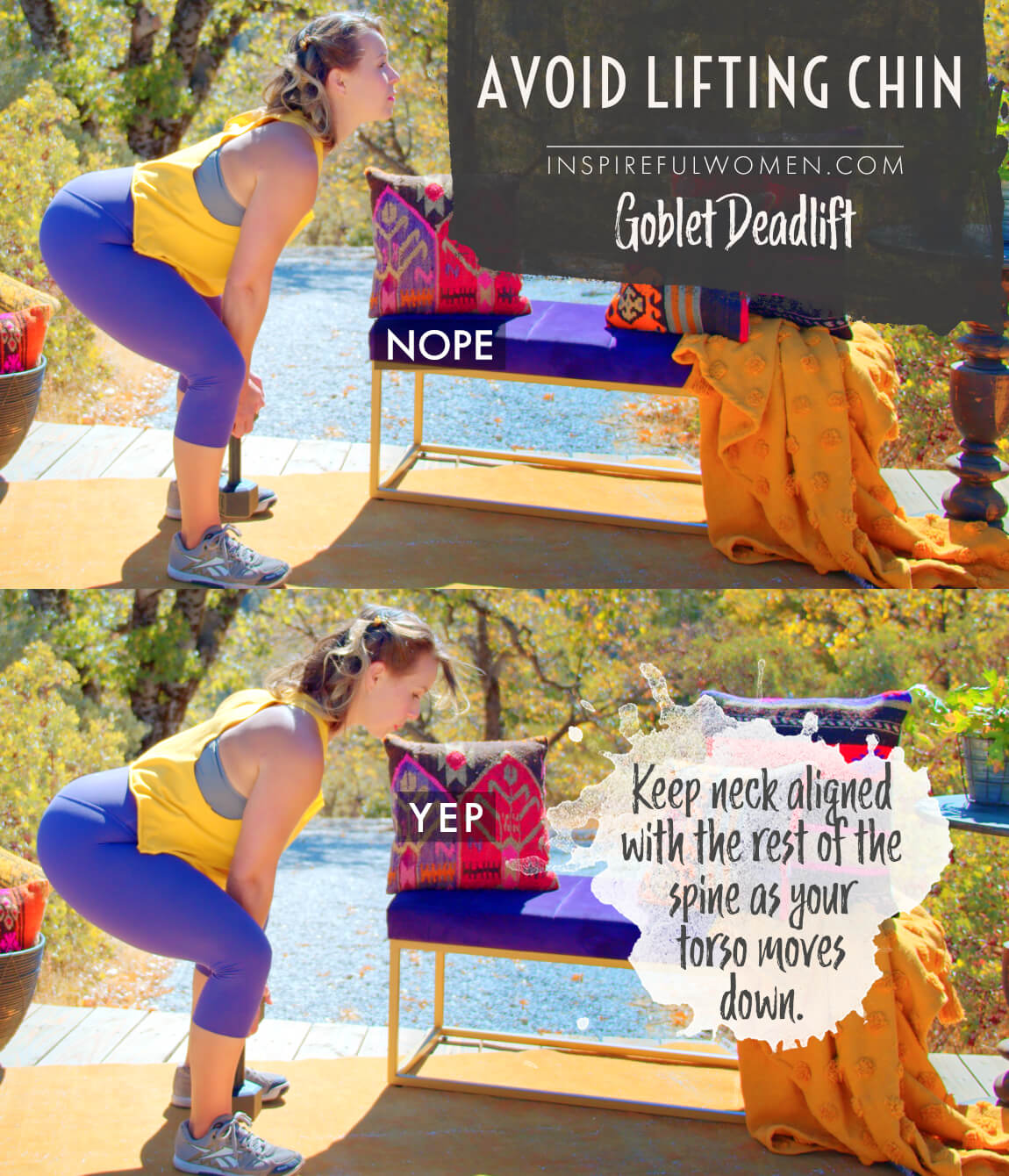
6. Avoid Rolling Forward To The Balls Of The Foot
AVOID: Rolling forward onto the ball of the foot.
WHY NOT?
- This happens when you have tight calf muscles (gastroc, soleus).
- This can also happen if you have restrictions in the mobility of your ankle joints
- Work on lifting your toes up off of the floor when the foot is flat on the floor
- Do this in sitting when the knee is bent and in standing when the knee is straight.
- This can put too much strain on the knee joint.
- The quadriceps will do more of the work.
WHAT TO DO:
- Try stretching your calf muscles.
- Put a lift under your toes to get your weight back.
- Make sure the weight is close to your body and not pulling you forward.
- Set your weights on elevated objects (placed on the sides of your legs), so that you don’t have to bend down as far.
- Do Romanian Deadlifts until you have improved the flexibility of your ankles.
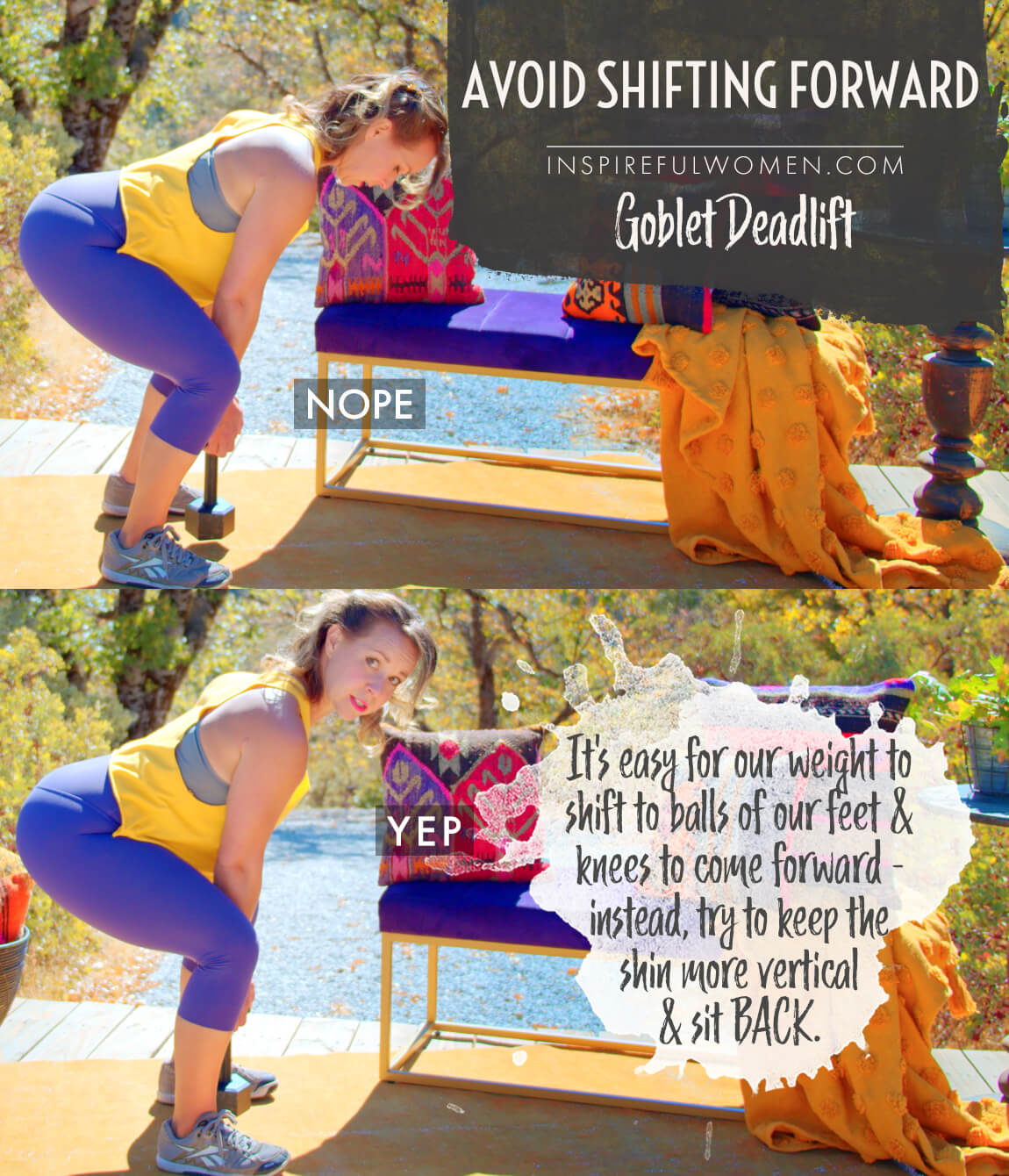
7. Avoid Locking Knees
AVOID: Hyperextending or locking the knees at the top of the movement
WHY NOT?
- This puts too much strain on the knee joints, using the ligaments and joint surface to stabilize the joint.
WHAT TO DO:
- The legs will straighten as you stand up tall, but the knees should be soft - not locked back.
- Keep the knee soft to protect the joint and also to keep the leg muscles engaged.
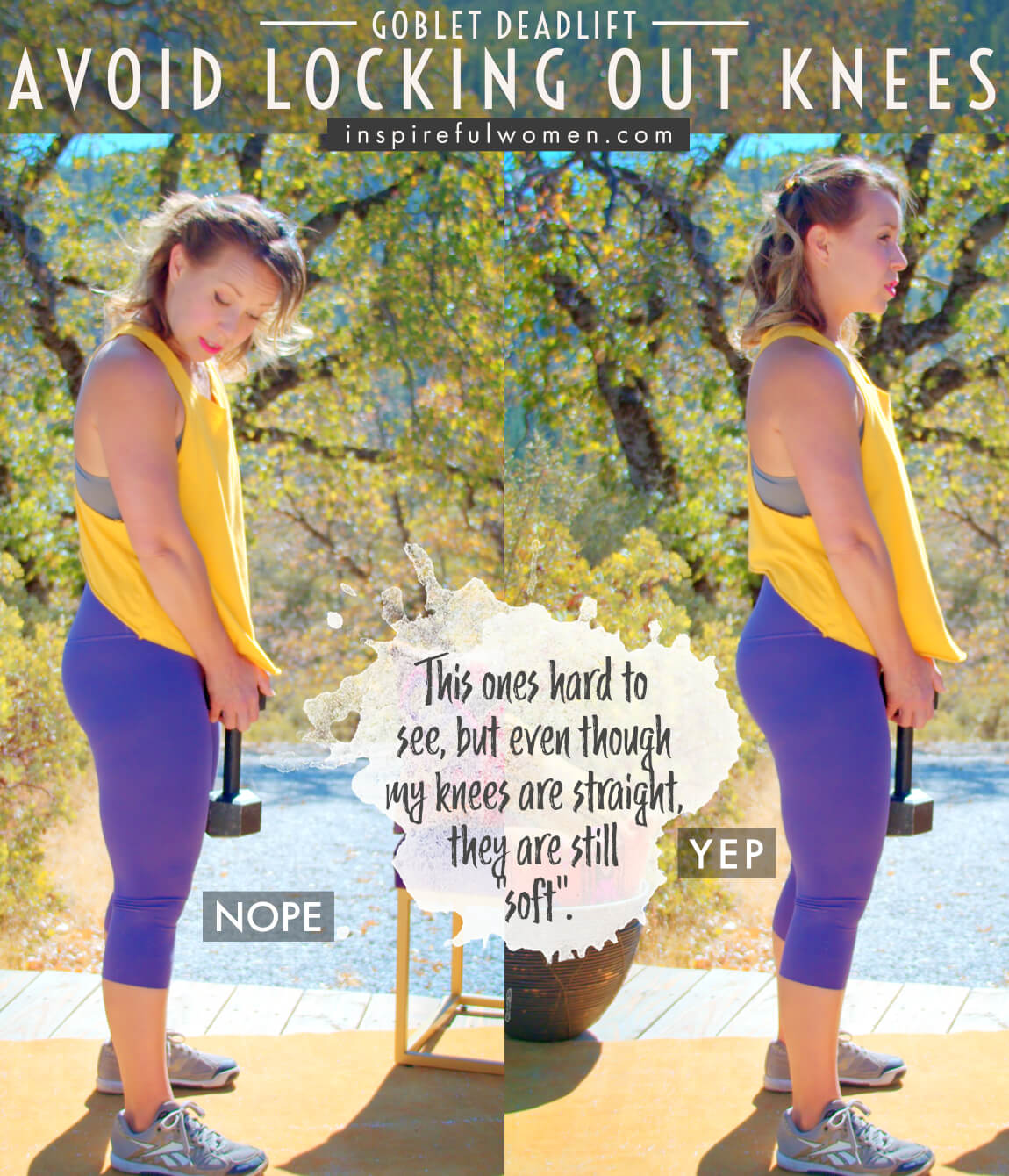
8. Avoid knees Caving In/out
AVOID: Letting the feet or knees lean in or out
WHAT TO DO:
- Keep the ankles and knees aligned during the exercise.
- The knees should travel over the second and third toe as you lower down and lift the weight.
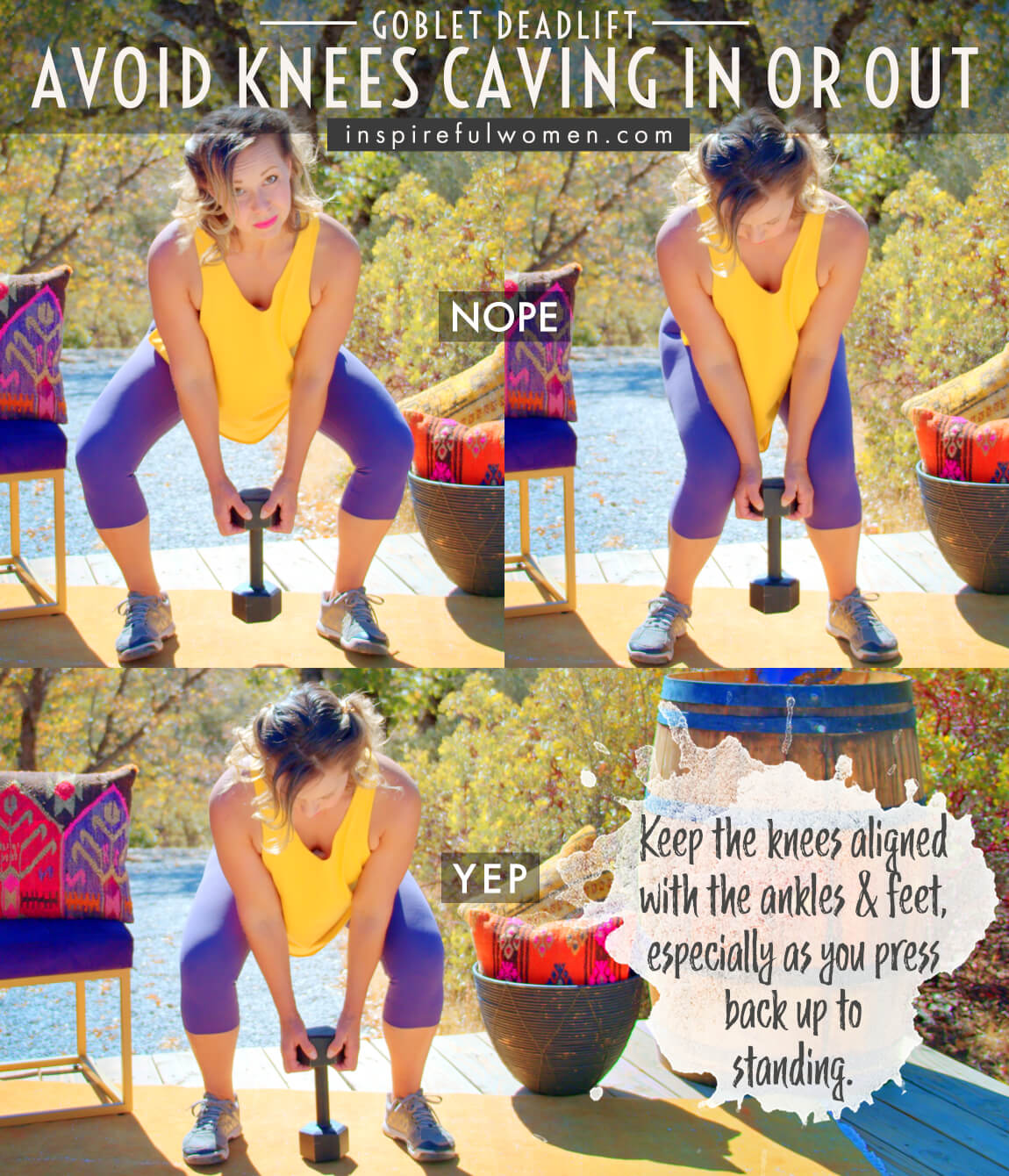
MAKE IT EASIER
EASIER
MAKE THE MOVEMENT MORE DOABLE
Raised Surface
Raised Surface Goblet Deadlift
Set the weights on small bench or yoga blocks if you are having trouble squatting all the way down with a neutral spine.
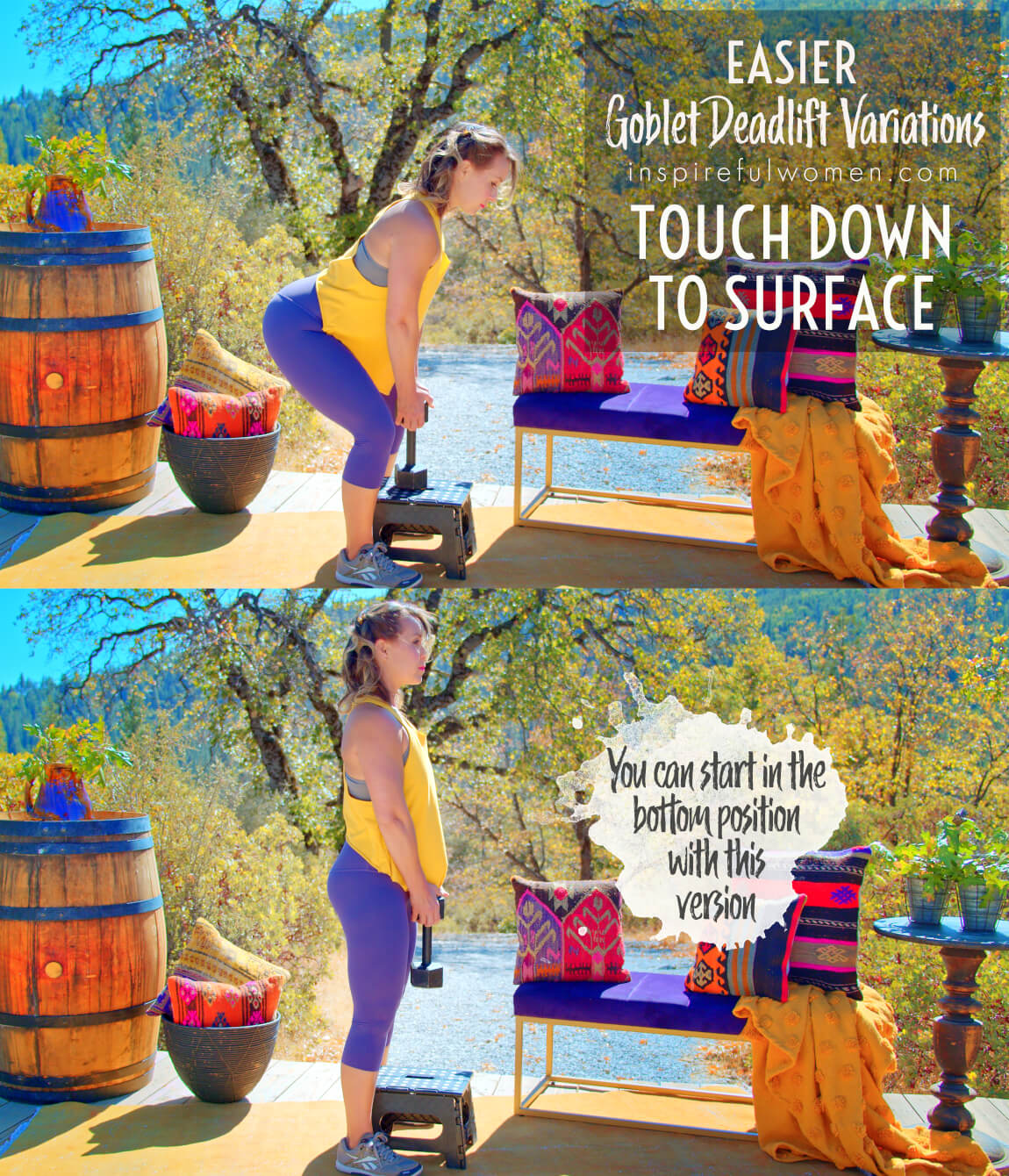
WHAT WE'RE DOING TODAY
WHAT & WHY
BENEFITS OF TRAINING THE POSTERIOR CHAIN MUSCLES
WHAT
TRAINING FOR SOMETHING WE DO EVERYDAY
There are 2 main ways we safely lift heavy things from the floor - squatting & deadlifting.
With both of these positions, the goal is to maintain a neutral spine, moving from the hips and knees not from the back, and having the load as close as possible to your body.
In both of these lifts the weight is lifted from a position close to the feet. When you lift from the floor the load needs to be close to your body. A squat requires more calf length (not tight), knee and hip range of motion and good core strength. Doing a squat with good form helps to work on all of this, but you will be limited in adding resistance because if you add resistance - first your form has to be perfect. If you are limited in these areas but you want to work on increasing your strength then the deadlift could be an option.
Deadlifts are basically lifting a heavy object from the floor. It is a movement that we do all day long lifting children and other heavy items like groceries and laundry. The exercise begins with hinging at the hips. The core muscles are working to hold the spine in neutral. Once the hips are hinged forward, the weight is lifted up using the leg muscles. A benefit of the deadlift is that with good form you should be able to lift quite a bit of weight. What this means is that you might want to eventually invest in some heavier dumbbells or a heavy kettlebell for these. We have 3 very large sets of muscles (quads, hamstrings & glutes) helping out in this exercise (and remember there's 2 of each!) so they can move a lot of weight working all together. And you are not working them through a very big range of motion.
Additionally, it is much easier to do a deadlift than a squat with correct form - easier to keep the spine in neutral because the hip flexion is not as great as a squat. And the muscles are at a length where they are stronger (length-tension curve). Making it a good choice for really working the muscles of the arms, core, and legs. But, it is essential to lift the heavy weight with proper form to avoid hurting your back.
IT’S ALL ABOUT THE HIP HINGE
The main movement in this exercise is hip hinging, leaning over from the hips (where the hips crease) and then using the hip extensors (gluteus maximus and hamstrings) to straighten the hips/stand back up. It seems like a simple movement but it is often performed with very poor form. Many people bend their backs instead of hinging at the hips. With this approach, the back muscles are trying to lift the heavy weight instead of the larger and more powerful leg muscles, this form can end up really straining the low back.
WHY BOTHER DOING IT?
WHY
WHY DO WE EVEN CARE?
STRONG BACKSIDES = HEALTHY BACK, HIPS & KNEES
Strong hamstrings and glutes are needed to keep the back, hips, and knees healthy. They work with all of the other muscles of the core and legs to keep the joints aligned and cushion the impact, and they do this while we move our bodies in various ways and with various amounts of weight or resistance.
FOCUS ON CREATING STRONG, POWERFUL STRIDES & LOWER BODY MOVEMENT IN EVERYDAY LIFE
Hamstring exercises often focus on movements that bend the knees, like hamstring curls, to target the hamstrings. The problem with this is that one of the important jobs of the hamstrings is to pull the hip back (extension) - this is when you go from for instance standing, to taking a step forward, the trailing leg/back leg, is now in “extension” - from the hip joint, your leg is behind you. In fact this function is how we use our hamstrings most throughout the day - for walking, running, getting up from a chair, and climbing stairs. Deadlifts are a really good way to train the hamstrings in coordination with the gluteus maximus to pull the hip back from a bent position.
In order to lift properly we need 1). strong legs, 2). core strength to stabilize the spine in a neutral position, and 3). mobility in our hips.
Learning how to do deadlifts with proper form will help us with the first two:
build the leg and core strength needed to improve the way that you lift during your daily activities. Good posture and body mechanics, along with strong leg and core muscles and joint mobility will lessen the damage to the joints of the lumbar spine and hips from degenerative changes that occur with age.
LEARN PROPER BACK POSITION WHEN LIFTING STUFF WITH THIS EXERCISE
Chances are good that you will experience back pain at some time in your life. It makes sense to learn to use the body as it is designed to be used. The legs are designed for strength and power.
The back is designed to keep us upright and to provide a base of support for the legs and arms to move from, the back is not designed for heavy lifting. The back plays more of supportive stabilizing role in heavy lifting, like with the deadlift, the legs are doing the standing back up with the heavy weight, and the back and arms are working in a supportive role to stabilize oneself while holding that heavy weight.
Learning the correct way to lift heavy items from the floor, and strengthening the leg muscles can help to prevent back injuries and damage to the small joints of the spine that can happen due to poor lifting technique. One key to keeping your back healthy is to keep your legs strong so they can do the heavy lifting, decreasing the strain on the back.
This is an excellent exercise when it is performed correctly but can cause back injury when the form is incorrect.
*** special caution with osteoporosis, spondylolisthesis, spondylolysis or history of disc pathology.
EVERYDAY LIFE
EVERYDAY LIFE &
MUSCLE FUNCTION
HOW WE USE OUR POSTERIOR CHAIN MUSCLES IN EVERYDAY LIFE
1. STRAIGHTENING (EXTENSION) THE HIPS AND KNEES
- Standing from a sitting position
- Walking up stairs
- Lifting an item off of the floor
- Climbing a ladder
- Walking uphill
- Getting up from the floor
SCIENCY STUFF
SCIENCY STUFF
SPIFFILICIOUS FACTS ABOUT MUSCLES & MOVES
The legs are designed for strength and power. What shows us this is the case? The design of the muscle - the shape, orientation, location - origin and insertion points, size (length and bulk), and muscle fiber type. Take the quadriceps muscle for example - all four muscles join at a shared tendon which has the patella embedded in it. The patella acts as a pulley system - making the muscle capable of very large forces.
Compare that with the erector spinae - which is really a lot of different sections of muscle that attach on the vertebrae spanning a few segments at a time - they are fairly short muscles and they overlap from the neck to the pelvis - the layer upon layer provides support, not a lot of movement - especially at each individual segment, and the muscle type is more aerobic - designed for endurance, they can’t handle the heavy lifting.
Bending forward at the spine and lifting heavy items, especially if you are slightly rotated during the movement, can lead to damage to the discs in the spine. Why is this? It has a lot to do with the design of the discs -the way the collagen fibers of the discs are arranged in a crisscross pattern with the bottom part attached to the vertebra below. When you rotate only half of the fibers will become taut, and the other half (which are oriented diagonally in the other direction) will be relaxed. This provides only 50% of the structural support, making it more vulnerable to injury.
1. The position stretches some of the supporting ligaments to their end range, there is a weak area in the back on each side. Bending compresses the discs in the front and causes the nucleus to be pushed to the back - pushing it back toward the weak area. This is how a herniated or bulging disc occurs.
2. There are two facet joints which are made up of the small bony protrusions off of each vertebra - for example, L4 and L5 both have little bony parts sticking off of the sides of the vertebrae - these for the facet joints between L4-5. When you rotate you lock out the joint - where the joint is most compressed. It is easier to irritate the joint in this position.
The back is designed to keep us upright and to provide a base of support for the legs and arms to move from, the back is not designed for heavy lifting. So the back plays more of a supportive stabilizing role in heavy lifting then- like with the deadlift, the legs are doing the standing back up with the heavyweight, and the back and arms are working in a supportive role to stabilize oneself while holding that heavy weight.
Kind of like using a lever to lift something - you put a crowbar under something and push down on one end. The spine is like the crowbar. If it was not strong enough to lift the support the object as you push down with your arm then it will bend, or break.
ALLLL MUSCLES & WHEN
ALL MUSCLES WORKING & WHEN DURING THE Goblet Deadlift
The hand and arm muscles become active when the weight is lifted from the floor and stay active throughout the exercise to hold the weights.
The quadriceps and gastrocnemius contract concentrically to straighten the ankles and knees to lift the weight. The hamstrings, gluteus maximus and adductor magnus contract concentrically to lift the weighted torso by pulling the hips back to neutral and to standing.
The hamstrings, gluteus maximus and adductor magnus work eccentrically to hinge forward at the hips and move the torso from vertical towards horizontal. The back extensors become more active with more forward lean of the trunk.
The quadriceps and gastrocnemius work eccentrically to control the weight of the body as the knees and ankles bend to lower the body down towards the floor.
PIN IT FOR LATER!
